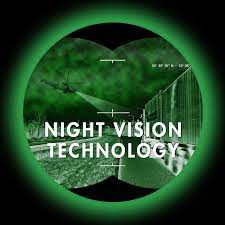Night vision technology has made remarkable strides since its inception in WWII when image intensification first aided soldiers in darkness. Its evolution has been substantial — incorporating thermal imaging and digital image enhancement and expanding beyond the military sector. Nowadays, it finds applications in civilian life, too, permeating fields such as aviation, security services, and even recreational activities like hunting. The pace of advancement in night vision technology is rapid, making it challenging to stay current. Staying informed and up-to-date is key to fully leveraging this ever-evolving technology’s latest features and benefits.
The Basics of Night Vision Technology
Night vision technology has evolved drastically. It enables humans to observe in low light or absolute darkness by intensifying light.
The process begins with an objective lens, which collects the surrounding light or infrared radiation. This is then focused onto an image intensifier tube.
Photons strike a photocathode inside the tube, releasing electrons via a photoelectric effect. Then, these electrons are accelerated and multiplied in a process called electron cascading. This creates a brighter image, which is projected onto a phosphor screen. It is converted back into visible light and seen through the eyepiece.
Night vision was initially developed for military applications during World War II. The early versions used active infrared illumination, which was detectable by enemies.
But, the invention of passive night vision systems changed the game. They depend on available ambient light and infrared radiation from objects. These systems don’t need active illumination but offer improved stealth capabilities.
Early Developments in Night Vision Technology
Early progress in night vision tech has completely changed how we view and work in low-light conditions. Not only has it made military operations stronger, but it’s also been used in law enforcement and wildlife observation.
- This advancement began during WWII when the German army developed an infrared aiming sight for firearms.
- Then, the US military got involved with night vision and developed the ‘sniper scope,’ which let soldiers see even in total darkness.
- In the ’60s, image intensification tech was developed, increasing available light for better nighttime vision.
These early inventions paved the way for today’s more advanced night vision technology. One interesting note is that NASA contributed a lot to the progress of night vision tech through its research and development.
Advancements in Night Vision Technology
Significant progress has been made in night vision tech. This has improved the capabilities and effectiveness of night vision devices and opened new doors of opportunity for various industries.
- Miniaturization: Night vision goggles and cameras are now smaller and lighter.
- Enhanced Image Quality: Images are now more transparent, sharper, and higher-res for easier identification.
- Extended Range: Longer detection ranges mean users can see further in pitch-black settings.
- Integration with Other Technologies: Night vision combines thermal imaging for a more comprehensive view.
Other changes have contributed to night vision tech’s evolution. Digital night vision has eliminated many limitations of analog systems. Lightweight materials and advanced optics have improved user comfort and visual performance.
In one real-life example, enhanced night vision tech saved a lost hiker. With upgraded goggles, rescue teams quickly located the hiker and returned them safely.
Night vision tech is now used in military, law enforcement, wildlife observation, and recreational activities such as night photography. The bright future will undoubtedly improve our ability to navigate and operate in the dark.
Applications of Night Vision Technology
Night vision technology has been used throughout history in various fields. In the military, it helps soldiers to see and operate in the dark. Law enforcement agencies also use it for surveillance. Wildlife observation and conservation benefit from it, too; researchers can watch nocturnal animals without disrupting them.
In the medical field, night vision technology has advanced significantly. It is now used for surgical procedures, allowing doctors to operate with more precision and less risk. In the automotive industry, night vision systems detect hazards on the road in low light conditions, making driving safer.
The first generation of infrared devices for military use was developed during World War II. These were bulky and inefficient compared to later models. But, they eventually led to further innovation and refinement in night vision technology.
Over the years, newer night vision devices were created with improved image quality and smaller form factors. It is no longer just for military use; civilians also use night vision technology.
Challenges and Limitations of Night Vision Technology
Night vision tech faces multiple issues and difficulties in its growth. These problems are a regular worry for engineers and researchers striving to boost this cutting-edge tech.
- Limited Range: A major hurdle of night vision tech is its small range. Despite progress, the viewing distance still needs to be improved compared to day vision.
- Reduced Quality: Night vision gadgets often show images with lower resolution and quality than those seen during the day. This drawback stops clear visibility and recognition of objects in dark settings.
- Depends on Ambient Light: Another concern faced by night vision tech is its reliance on ambient light sources such as moonlight or starlight. In areas with minimal natural light, the efficiency of night vision devices decreases significantly.
- Vulnerable to Blinding Effects: Light sources like vehicle headlights or spotlights can cause temporary blindness when using night vision tech. This risk is exceptionally high for military personnel and law enforcement officers relying on these devices in critical moments.
Despite these limits, continuing research and technological progress keep addressing these issues to advance night vision abilities even more.
Manufacturers have lately released cutting-edge night vision devices with infrared illuminators that emit infrared light invisible to the eye but detectable by the device’s sensors.
In World War II, British engineer Sir Howard Grubb created an early form of active infrared nighttime imaging device known as “Grubbscope.” This invention greatly assisted soldiers’ visibility in low-light conditions during battle operations.
As researchers continue to develop better solutions and conquer existent limitations, the evolution of night vision tech looks forward to a future where darkness will no longer obstruct our ability to see and explore the world.
Prospects and Emerging Trends in Night Vision Technology
The future of night vision technology is replete with potential, with industry leaders like Steel Industries revolutionizing the lead time associated with these devices. This progress promises improved image quality, extended range, superior resolution, and the exciting prospect of Artificial Intelligence integration. Innovations like thermal imaging already detects heat signatures, benefiting law enforcement, wildlife observation, and rescue operations. Augmented Reality systems overlay digital information onto real-world views, offering users a deeper understanding of their surroundings. At the same time, sensors are becoming increasingly sensitive, capturing more explicit images even in low-light conditions. Image processing algorithms are taking night vision to a new level, a feat that Steel Industries is actively contributing to. This technology is not confined to professional use, as civilians, such as hunters and campers, can also benefit. As innovation relentlessly pushes boundaries, it continues revolutionizing how we interact with darkness.
Conclusion
In the ever-changing world of night vision, advancements have changed how we perceive darkness. Progress has enabled improved visibility in low-light conditions. This revolutionized many industries that rely on nighttime operations.
A noteworthy change is thermal imaging technology. It detects heat signatures, not just available light. This breakthrough provides clear and detailed imagery even in pitch black. It is invaluable for military ops, search & rescue, and wildlife monitoring.
AI algorithms have been integrated into night vision devices. Through deep learning, they can recognize & classify objects accurately, even in challenging environments. This improves security personnel’s situational awareness, allowing them to identify potential threats during nighttime patrols quickly.
Notably, the US military played a significant role in driving the development of night vision technologies. American scientists created early versions of night vision devices during WWII, known as “sniper scopes.” These gave soldiers a significant edge on the battlefield. This pioneering work built the foundation for future advancements and led the way for our modern night vision.





Be First to Comment